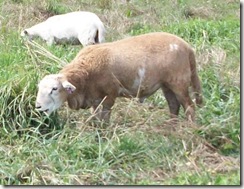 Ok, I have notes from three more speakers I heard at the KHSI Expo in Corvallis. Dr. Jim Miller addressed parasite control; he is from the Veterinary Medical School at Louisiana State University. He is also one of the founders of the Southern Consortium for Small Ruminant Parasite Control.
Ok, I have notes from three more speakers I heard at the KHSI Expo in Corvallis. Dr. Jim Miller addressed parasite control; he is from the Veterinary Medical School at Louisiana State University. He is also one of the founders of the Southern Consortium for Small Ruminant Parasite Control.
So, we know that worms, especially certain types of worms, can be a serious threat to sheep. The barber pole worm (Haemonchus contortus) is one of the worst, they are literal blood suckers that cause acute anemia, and often death. The brown stomach worm (Telodorsagia circumcincta) disrupts the abomasum, causes diarrhea with weight loss, and is common in the Pacific northwest.
I have a stack of sheep books at home that tell you all the times you should be de-worming your whole flock: before breeding, after lambing, at the end of the summer, when the rainy season hits, at the onset of winter, yadda yadda. But, we know now, this is old school! 😀
The trouble with this de-worm-everybody-all-the-time approach is that it actually increases your worm problem over time. And note that I’m using the proper terminology, as Dr. Miller pointed out, we don’t “worm” sheep, we “de-worm” them (and I admit, I’m very guilty of using the sloppy former term often enough!). Sheep need continual exposure to worms in order to develop resistance to them, so some presence worms is actually desirable.
Each time you de-worm, you will likely not kill all the worms. The ones that survive are super-worms that are resistant to the drug you are using. So every time you kill of their competitors, you are helping along this population of super-worms, making it easier for them to thrive and multiply. Over time, your chosen de-wormer will become less and less effective, and your super-worm population will become more formidable. Dr. Miller cited that within three years, the wormer you are using can have reduced effectiveness of up to 20-40%! So, any new “miracle drug” introduced to the market as the end-all of de-wormers won’t be able to make that claim for long!
So, what to do? The new recommendation is to de-worm very selectively. Only de-worm animals that you know actually need it, by doing fecal egg counts, or at the very least, targeting animals with clinical signs (diarrhea, ill thrift). Dr. Miller said that 20-30% of your animals (the weakest ones) harbor most of the worms. You can also treat the most at-risk animals, especially high producing mothers while they are most stressed by mothering. Lambs also need to mature to 4-6 months before they are able to mount a serious resistance against worms, so they may need early de-worming help as well.
When you de-worm in this targeted fashion, you allow the rest of your untreated sheep to re-infect your pasture with the more desirable “weak” worms that are not resistant to the drugs you are using, and those worms offer competition to the super-worms, keeping their population in check. The newest recommendation is to stick to using the same de-worming medicine until it’s no longer effective enough for you, before switching to a new drug (i.e. don’t rotate drugs all the time). This, again, keeps from breeding too many super-worms in your environment that are resistant to one or more drugs.
I was disappointed to hear him say that herbal wormers have not been shown to be effective in any clinical studies, since I prefer natural methods. But I’m still heartened by this new movement away from the shotgun approach of worming the whole flock at high frequency!
When performing de-worming, Dr. Miller said you want to shoot for 95% or better removal of worms in the animals you are treating. So, ideally you need to be able to verify this with a fecal egg count before and after. This means working with your vet, or if you have a large enough operation to warrant it, buying your own microscope and EPG kit, and learning how to do it yourself (preferably from an expert). Dr. Miller mentioned that the Chalex Corporation in Issaquah sells such kits.
There is also the FAMACHA test, which looks at the redness, or lack thereof, of the below-the-eye tissue, compares it to a chart (which you should replace every year because the ink starts to fade), to assess anemia caused by barber pole worms, and the need for de-worming. The FAMACHA should be done every 2-3 weeks during worm seasons, and even weekly during periods of high concern.
Dr. Miller recommended withholding feed for 24 hours prior to de-worming for best effectiveness. He also said that it’s really important to get the drench gun to the back of the tongue. He explained that lambs (and goat kids) have a mechanism in their throats called the esophageal groove that, when suckling, allows milk to bypass the rumen and enter directly into the abomasum, where it is best digested by the immature animal (a cool explanation and illustration of all this here).
Later the rumen enlarges and develops as the lamb begins to eat forage, and in most mature animals the esophageal groove eventually goes away. But, not always, and if when you are drenching, if you let the sheep “suckle” on the drench gun, you may activate that esophageal groove, shooting the medicine right into the abomasum (fourth stomach), and it’ll miss killing the worms that are hanging out in the first three stomachs (the rumen, reticulum, and omasum). So, drench gun: back of mouth, behind the tongue!
So interesting! Even though we have goats, I’ve learned alot from this. Thanks for taking the time to share your notes. 🙂